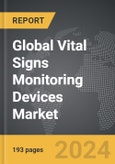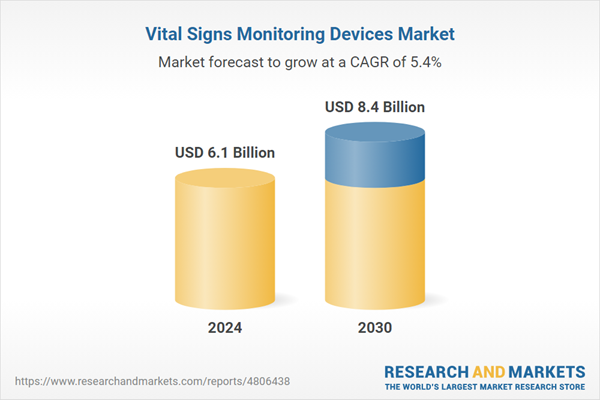The global market for Vital Signs Monitoring Devices was valued at US$6.1 Billion in 2024 and is projected to reach US$8.4 Billion by 2030, growing at a CAGR of 5.4% from 2024 to 2030. This comprehensive report provides an in-depth analysis of market trends, drivers, and forecasts, helping you make informed business decisions. The report includes the most recent global tariff developments and how they impact the Vital Signs Monitoring Devices market.
Segments: Segments (Blood Pressure Monitoring Devices, Pulse Oximeters, Temperature Monitoring Devices).
Geographic Regions/Countries: World; United States; Canada; Japan; China; Europe (France; Germany; Italy; United Kingdom; Spain; Russia; and Rest of Europe); Asia-Pacific (Australia; India; South Korea; and Rest of Asia-Pacific); Latin America (Argentina; Brazil; Mexico; and Rest of Latin America); Middle East (Iran; Israel; Saudi Arabia; United Arab Emirates; and Rest of Middle East); and Africa.
The analysts continuously track trade developments worldwide, drawing insights from leading global economists and over 200 industry and policy institutions, including think tanks, trade organizations, and national economic advisory bodies. This intelligence is integrated into forecasting models to provide timely, data-driven analysis of emerging risks and opportunities.
Global Vital Signs Monitoring Devices Market - Key Trends & Drivers Summarized
How Are Vital Signs Monitoring Devices Transforming Healthcare?
Vital Signs Monitoring Devices are revolutionizing the healthcare landscape by providing continuous, real-time monitoring of critical health parameters such as heart rate, blood pressure, oxygen saturation, and temperature. These devices are essential in hospitals, clinics, and home care settings, enabling early detection of potential health issues and timely intervention. The market for these devices has seen a surge in demand, particularly due to the increasing prevalence of chronic diseases, the aging population, and the growing focus on personalized healthcare. Wearable health monitors, portable multi-parameter monitors, and remote patient monitoring devices are becoming increasingly popular, allowing for continuous tracking of vital signs and providing valuable data for clinicians to manage patient care more effectively. In home care settings, these devices empower patients to manage their health proactively, reducing the need for frequent hospital visits.What Are the Technological Innovations Driving the Vital Signs Monitoring Devices Market?
Technological advancements have significantly transformed Vital Signs Monitoring Devices, making them more accurate, portable, and user-friendly. The integration of wireless technology, artificial intelligence, and machine learning has enabled the development of smart monitoring devices that provide real-time health analytics and predictive insights. Wearable devices, such as smartwatches and fitness trackers, are now equipped with advanced sensors that can monitor multiple vital signs simultaneously, providing a comprehensive view of an individual's health status. The emergence of telemedicine and remote monitoring solutions, particularly during the COVID-19 pandemic, has accelerated the adoption of these devices. Innovations in biosensors, miniaturization of components, and the development of non-invasive monitoring technologies are further enhancing the functionality and appeal of these devices in both clinical and non-clinical settings.What Challenges and Opportunities Are Present in the Vital Signs Monitoring Devices Market?
The Vital Signs Monitoring Devices market faces several challenges, including data privacy concerns, regulatory compliance, and integration with existing healthcare systems. Ensuring the accuracy and reliability of these devices is critical, as inaccurate readings can lead to misdiagnosis and improper treatment. Data privacy is another significant concern, especially with the increasing use of cloud-based platforms and mobile applications for health monitoring. However, these challenges also create opportunities for innovation and market growth. The increasing focus on preventive healthcare, personalized medicine, and patient-centric care is driving demand for advanced vital signs monitoring solutions. The growing adoption of digital health technologies and telemedicine is further expanding the market, providing new opportunities for companies to develop integrated, AI-driven solutions that offer enhanced patient care and outcomes.The Growth in the Vital Signs Monitoring Devices Market Is Driven by Several Factors…
The growth in the Vital Signs Monitoring Devices market is driven by several factors, including the rising prevalence of chronic diseases, the aging global population, and the increasing adoption of telemedicine and remote monitoring solutions. The demand for continuous, real-time health monitoring is particularly high among patients with conditions like hypertension, diabetes, and cardiovascular diseases, where regular monitoring is crucial for effective management. Technological advancements, such as the integration of AI and machine learning for predictive health analytics, are also driving market growth. The increasing trend towards home-based care and the rising popularity of wearable health devices, such as smartwatches with integrated health sensors, are further fueling demand. Additionally, the ongoing digital transformation of healthcare, with a focus on enhancing patient outcomes and reducing healthcare costs, is contributing to the rapid expansion of the Vital Signs Monitoring Devices market.Report Scope
The report analyzes the Vital Signs Monitoring Devices market, presented in terms of units. The analysis covers the key segments and geographic regions outlined below.Segments: Segments (Blood Pressure Monitoring Devices, Pulse Oximeters, Temperature Monitoring Devices).
Geographic Regions/Countries: World; United States; Canada; Japan; China; Europe (France; Germany; Italy; United Kingdom; Spain; Russia; and Rest of Europe); Asia-Pacific (Australia; India; South Korea; and Rest of Asia-Pacific); Latin America (Argentina; Brazil; Mexico; and Rest of Latin America); Middle East (Iran; Israel; Saudi Arabia; United Arab Emirates; and Rest of Middle East); and Africa.
Key Insights:
- Market Growth: Understand the significant growth trajectory of the Blood Pressure Monitoring Devices segment, which is expected to reach US$3.8 Billion by 2030 with a CAGR of a 5.2%. The Pulse Oximeters segment is also set to grow at 5.9% CAGR over the analysis period.
- Regional Analysis: Gain insights into the U.S. market, valued at $1.6 Billion in 2024, and China, forecasted to grow at an impressive 8.1% CAGR to reach $1.9 Billion by 2030. Discover growth trends in other key regions, including Japan, Canada, Germany, and the Asia-Pacific.
Why You Should Buy This Report:
- Detailed Market Analysis: Access a thorough analysis of the Global Vital Signs Monitoring Devices Market, covering all major geographic regions and market segments.
- Competitive Insights: Get an overview of the competitive landscape, including the market presence of major players across different geographies.
- Future Trends and Drivers: Understand the key trends and drivers shaping the future of the Global Vital Signs Monitoring Devices Market.
- Actionable Insights: Benefit from actionable insights that can help you identify new revenue opportunities and make strategic business decisions.
Key Questions Answered:
- How is the Global Vital Signs Monitoring Devices Market expected to evolve by 2030?
- What are the main drivers and restraints affecting the market?
- Which market segments will grow the most over the forecast period?
- How will market shares for different regions and segments change by 2030?
- Who are the leading players in the market, and what are their prospects?
Report Features:
- Comprehensive Market Data: Independent analysis of annual sales and market forecasts in US$ Million from 2024 to 2030.
- In-Depth Regional Analysis: Detailed insights into key markets, including the U.S., China, Japan, Canada, Europe, Asia-Pacific, Latin America, Middle East, and Africa.
- Company Profiles: Coverage of players such as ALPHATEC SCIENTIFIC, Bistos Co., Ltd., Bomimed, Contec Medical Systems Co., Ltd., Criticare Technologies and more.
- Complimentary Updates: Receive free report updates for one year to keep you informed of the latest market developments.
Some of the 44 companies featured in this Vital Signs Monitoring Devices market report include:
- ALPHATEC SCIENTIFIC
- Bistos Co., Ltd.
- Bomimed
- Contec Medical Systems Co., Ltd.
- Criticare Technologies
- Dott Medical Co., Ltd.
- Dragerwerk AG & Co. KGaA
- E-Control Systems, Inc.
- GHR Healthcare
- Glen Dimplex Professional Appliances - Lec Medical
Tariff Impact Analysis: Key Insights for 2025
Global tariff negotiations across 180+ countries are reshaping supply chains, costs, and competitiveness. This report reflects the latest developments as of April 2025 and incorporates forward-looking insights into the market outlook.The analysts continuously track trade developments worldwide, drawing insights from leading global economists and over 200 industry and policy institutions, including think tanks, trade organizations, and national economic advisory bodies. This intelligence is integrated into forecasting models to provide timely, data-driven analysis of emerging risks and opportunities.
What’s Included in This Edition:
- Tariff-adjusted market forecasts by region and segment
- Analysis of cost and supply chain implications by sourcing and trade exposure
- Strategic insights into geographic shifts
Buyers receive a free July 2025 update with:
- Finalized tariff impacts and new trade agreement effects
- Updated projections reflecting global sourcing and cost shifts
- Expanded country-specific coverage across the industry
Table of Contents
I. METHODOLOGYII. EXECUTIVE SUMMARY2. FOCUS ON SELECT PLAYERSIII. MARKET ANALYSISSOUTH KOREAREST OF ASIA-PACIFICARGENTINABRAZILMEXICOREST OF LATIN AMERICAIRANISRAELSAUDI ARABIAUNITED ARAB EMIRATESREST OF MIDDLE EASTIV. COMPETITION
1. MARKET OVERVIEW
3. MARKET TRENDS & DRIVERS
4. GLOBAL MARKET PERSPECTIVE
UNITED STATES
CANADA
JAPAN
CHINA
EUROPE
FRANCE
GERMANY
ITALY
UNITED KINGDOM
SPAIN
RUSSIA
REST OF EUROPE
ASIA-PACIFIC
AUSTRALIA
INDIA
LATIN AMERICA
MIDDLE EAST
AFRICA
Companies Mentioned (Partial List)
A selection of companies mentioned in this report includes, but is not limited to:
- ALPHATEC SCIENTIFIC
- Bistos Co., Ltd.
- Bomimed
- Contec Medical Systems Co., Ltd.
- Criticare Technologies
- Dott Medical Co., Ltd.
- Dragerwerk AG & Co. KGaA
- E-Control Systems, Inc.
- GHR Healthcare
- Glen Dimplex Professional Appliances - Lec Medical
Table Information
| Report Attribute | Details |
|---|---|
| No. of Pages | 193 |
| Published | April 2025 |
| Forecast Period | 2024 - 2030 |
| Estimated Market Value ( USD | $ 6.1 Billion |
| Forecasted Market Value ( USD | $ 8.4 Billion |
| Compound Annual Growth Rate | 5.4% |
| Regions Covered | Global |









